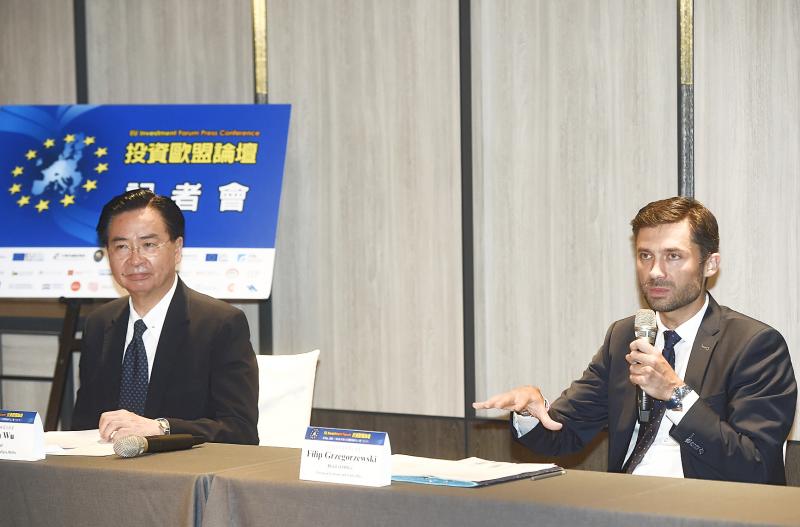More Taiwanese investments in Europe would yield economic gains and closer ties, European Economic and Trade Office in Taiwan Director Filip Grzegorzewski told a news conference yesterday ahead of the office’s first European Investment Forum in Taipei on Tuesday next week.
With one-quarter of Taiwan’s foreign direct investment being from the EU while only 2 percent of Taiwan’s outgoing investment going to the bloc, Grzegorzewski said he hoped that the forum would encourage more Taiwanese investment in Europe, resulting in stronger connections.
“We make jobs here [in Taiwan], we help Taiwan grow into an international economy,” he said. “Now we are attracting Taiwanese investment to Europe to balance this economic relationship, basically also to make sure our bond is strong. The more interactions we have, the more connected we get.”

Photo: Chien Jung-fong, Taipei Times
The forum, which seeks to pave the way for closer Taiwan-EU business cooperation in the post-COVID-19 world economy, would feature presentations on the information and communications technology, automotive and health industries in Europe, Grzegorzewski said.
Taiwanese businesses would share their experiences of investing in the EU, he said.
There is to be an investment fair at which Taiwanese investors can talk to representatives from EU member states directly to facilitate bilateral collaborations, he said.
Taiwanese firms can further expand their markets by investing in EU member states, leveraging from the 41 trade agreements the regional bloc has signed with 72 countries, he said.
Grzegorzewski said he is often asked why there is no European equivalent of the “Select USA” program, which introduces Taiwanese firms to opportunities in the US.
“This forum is the first step,” he said.
When asked whether trade ties with the EU might be affected by pressure from China, Minister of Foreign Affairs Joseph Wu (吳釗燮) told the news conference that Taiwan would not be intentionally provocative, but would keep on doing business.
“Going back decades now, China has never stopped threatening Taiwan with the use of force. And while the pressure has increased over the past few years, Taiwan is still a top investment destination in Asia and continues to be heavily favored by European investors,” Wu said.
Taiwan would continue with its policy of not rocking the boat, while keeping an eye on Chinese threats, he said.
“I believe that raising Taiwan’s visibility in Europe and Europe’s visibility in Taiwan is very important,” Wu said.
“I am sure we have all seen that the Taiwan-European relationship has been strengthening by leaps and bounds in the past year or two,” he said, citing the 90-member delegation that Czech Senate President Milos Vystrcil led to Taiwan.
The forum is to take place at the Taipei International Convention Center.
It is co-organized by the European Economic and Trade Office, EU member states’ representative offices, the Ministry of Economic Affairs and the Ministry of Foreign Affairs.

Taiwan Semiconductor Manufacturing Co (TSMC, 台積電) last week recorded an increase in the number of shareholders to the highest in almost eight months, despite its share price falling 3.38 percent from the previous week, Taiwan Stock Exchange data released on Saturday showed. As of Friday, TSMC had 1.88 million shareholders, the most since the week of April 25 and an increase of 31,870 from the previous week, the data showed. The number of shareholders jumped despite a drop of NT$50 (US$1.59), or 3.38 percent, in TSMC’s share price from a week earlier to NT$1,430, as investors took profits from their earlier gains

In a high-security Shenzhen laboratory, Chinese scientists have built what Washington has spent years trying to prevent: a prototype of a machine capable of producing the cutting-edge semiconductor chips that power artificial intelligence (AI), smartphones and weapons central to Western military dominance, Reuters has learned. Completed early this year and undergoing testing, the prototype fills nearly an entire factory floor. It was built by a team of former engineers from Dutch semiconductor giant ASML who reverse-engineered the company’s extreme ultraviolet lithography (EUV) machines, according to two people with knowledge of the project. EUV machines sit at the heart of a technological Cold

TAIWAN VALUE CHAIN: Foxtron is to fully own Luxgen following the transaction and it plans to launch a new electric model, the Foxtron Bria, in Taiwan next year Yulon Motor Co (裕隆汽車) yesterday said that its board of directors approved the disposal of its electric vehicle (EV) unit, Luxgen Motor Co (納智捷汽車), to Foxtron Vehicle Technologies Co (鴻華先進) for NT$787.6 million (US$24.98 million). Foxtron, a half-half joint venture between Yulon affiliate Hua-Chuang Automobile Information Technical Center Co (華創車電) and Hon Hai Precision Industry Co (鴻海精密), expects to wrap up the deal in the first quarter of next year. Foxtron would fully own Luxgen following the transaction, including five car distributing companies, outlets and all employees. The deal is subject to the approval of the Fair Trade Commission, Foxtron said. “Foxtron will be

INFLATION CONSIDERATION: The BOJ governor said that it would ‘keep making appropriate decisions’ and would adjust depending on the economy and prices The Bank of Japan (BOJ) yesterday raised its benchmark interest rate to the highest in 30 years and said more increases are in the pipeline if conditions allow, in a sign of growing conviction that it can attain the stable inflation target it has pursued for more than a decade. Bank of Japan Governor Kazuo Ueda’s policy board increased the rate by 0.2 percentage points to 0.75 percent, in a unanimous decision, the bank said in a statement. The central bank cited the rising likelihood of its economic outlook being realized. The rate change was expected by all 50 economists surveyed by Bloomberg. The